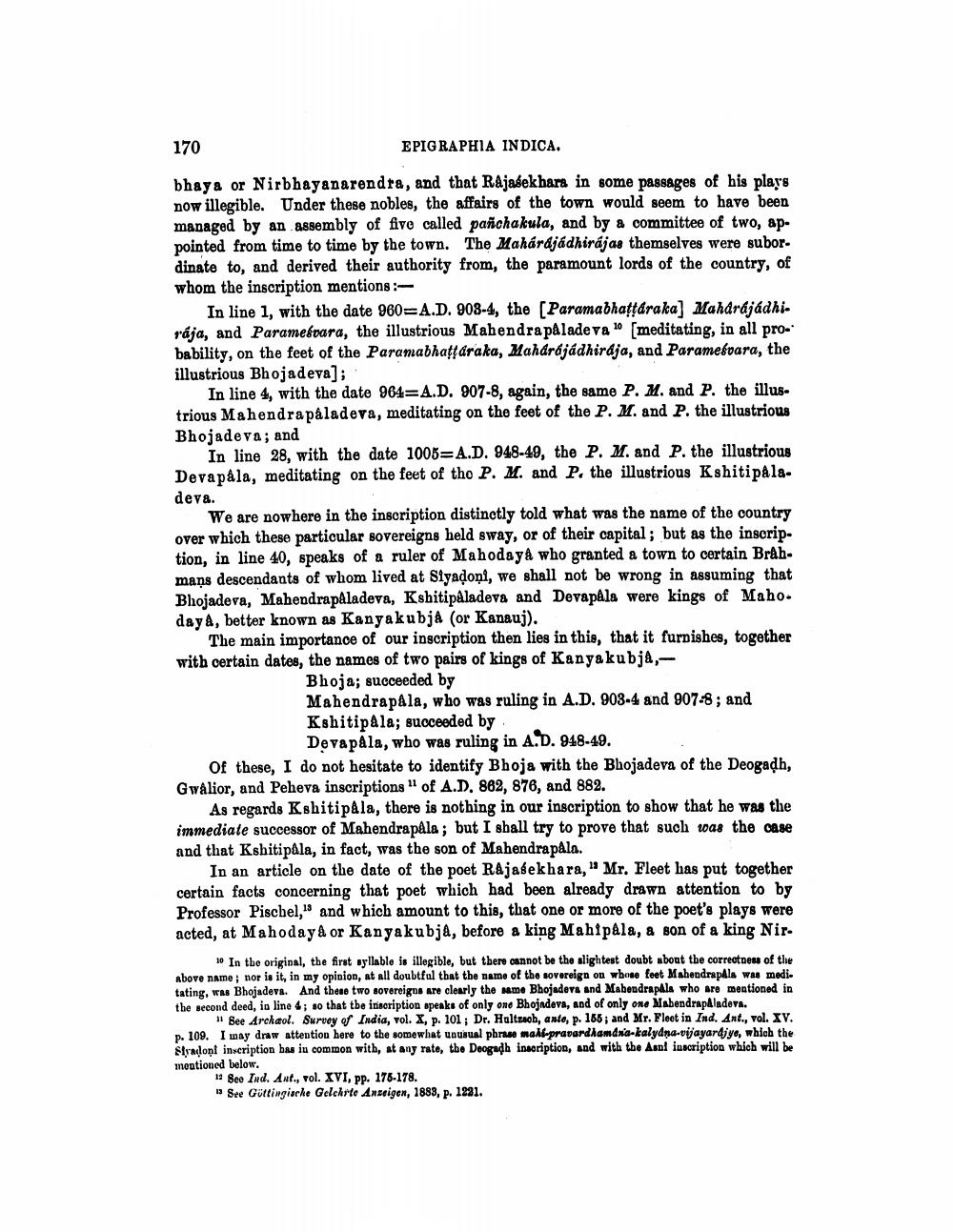________________
170
EPIGRAPHIA INDICA.
bhays or Nirbhayanarendra, and that Rajasekhara in some passages of his plays now illegible. Under these nobles, the affairs of the town would seem to have been managed by an assembly of five called pañchakula, and by a committee of two, appointed from time to time by the town. The Mahárájádhirájas themselves were subordinate to, and derived their authority from, the paramount lords of the country, of whom the inscription mentions:
In line 1, with the date 960mA.D. 908-4, the [Paramadhaffáraka] Makárájádhirája, and Paramefears, the illustrious Mahendrapaladeva [meditating, in all pro bability, on the feet of the Paramabhaffdraka, Makáréjádhirája, and Paramefoara, the illustrious Bhojadeva];
In line 4, with the date 964-A.D. 907-8, again, the same P. M. and P. the illus trious Mahendra pâladeva, meditating on the feet of the P. M. and P. the illustrious Bhojadeva; and
In line 28, with the date 1005 A.D. 948-49, the P. M. and P. the illustrious Devapála, meditating on the feet of the P. M. and P. the illustrious Kshitipala
deva.
We are nowhere in the inscription distinctly told what was the name of the country over which these particular sovereigns held sway, or of their capital; but as the inscription, in line 40, speaks of a ruler of Mahodaya who granted a town to certain Brâhmans descendants of whom lived at Siyaḍoni, we shall not be wrong in assuming that Bhojadeva, Mahendrapaladeva, Kshitipaladeva and Devapála were kings of Maho. daya, better known as Kanyakubja (or Kanauj).
The main importance of our inscription then lies in this, that it furnishes, together with certain dates, the names of two pairs of kings of Kanyakubjâ,
Bhoja; succeeded by
Mahendrapala, who was ruling in A.D. 903-4 and 907-8; and Kshitipala; succeeded by
Devapala, who was ruling in A.D. 948-49.
Of these, I do not hesitate to identify Bhoja with the Bhojadeva of the Deogadh, Gwalior, and Peheva inscriptions" of A.D. 862, 876, and 882.
As regards Kahitipals, there is nothing in our inscription to show that he was the immediate successor of Mahendrapala; but I shall try to prove that such was the case and that Kshitipâla, in fact, was the son of Mahendrapala.
In an article on the date of the poet Rajasekhara," Mr. Fleet has put together certain facts concerning that poet which had been already drawn attention to by Professor Pischel, and which amount to this, that one or more of the poet's plays were acted, at Mahodaya or Kanyakubj4, before a king Mahipals, a son of a king Nir.
10 In the original, the first syllable is illegible, but there cannot be the slightest doubt about the correctness of the above name; nor is it, in my opinion, at all doubtful that the name of the sovereign on whose feet Mahendrapala was medi tating, was Bhojadeva. And these two sovereigns are clearly the same Bhojadeva and Mahendrapala who are mentioned in the second deed, in line 4; so that the inscription speaks of only one Bhojadeva, and of only one Mahendrapaladeva.
11 See Archaol. Survey of India, vol. X, p. 101; Dr. Hultzsch, ante, p. 155; and Mr. Fleet in Ind. Ant., vol. XV. p. 109. I may draw attention here to the somewhat unusual phrase maki-pravardhamdna-kalydna-vijayardjye, which the Styadont inscription has in common with, at any rate, the Deogadh inscription, and with the Asni inscription which will be mentioned below.
12 See Ind. Ant., vol. XVI, pp. 175-178. "See Göttingische Gelehrte Anzeigen, 1883, p. 1231.




